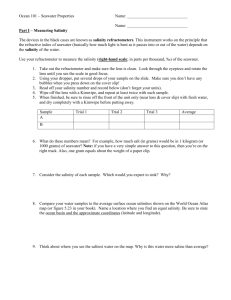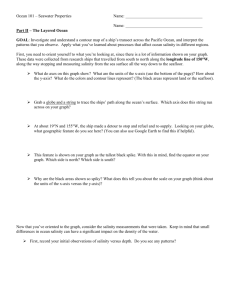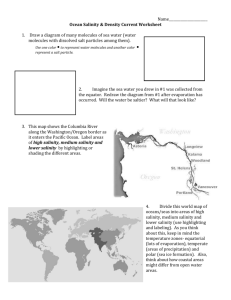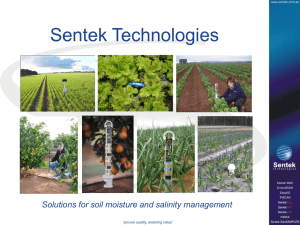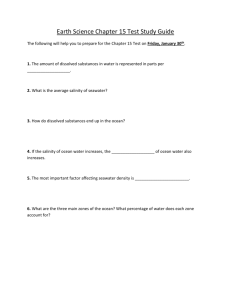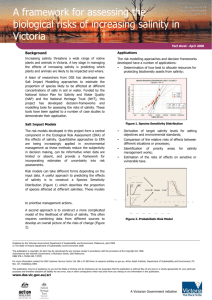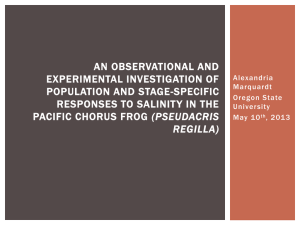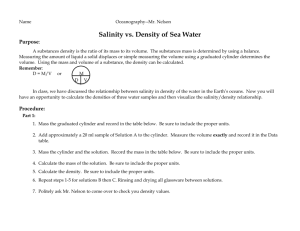Salinity Exercise
advertisement
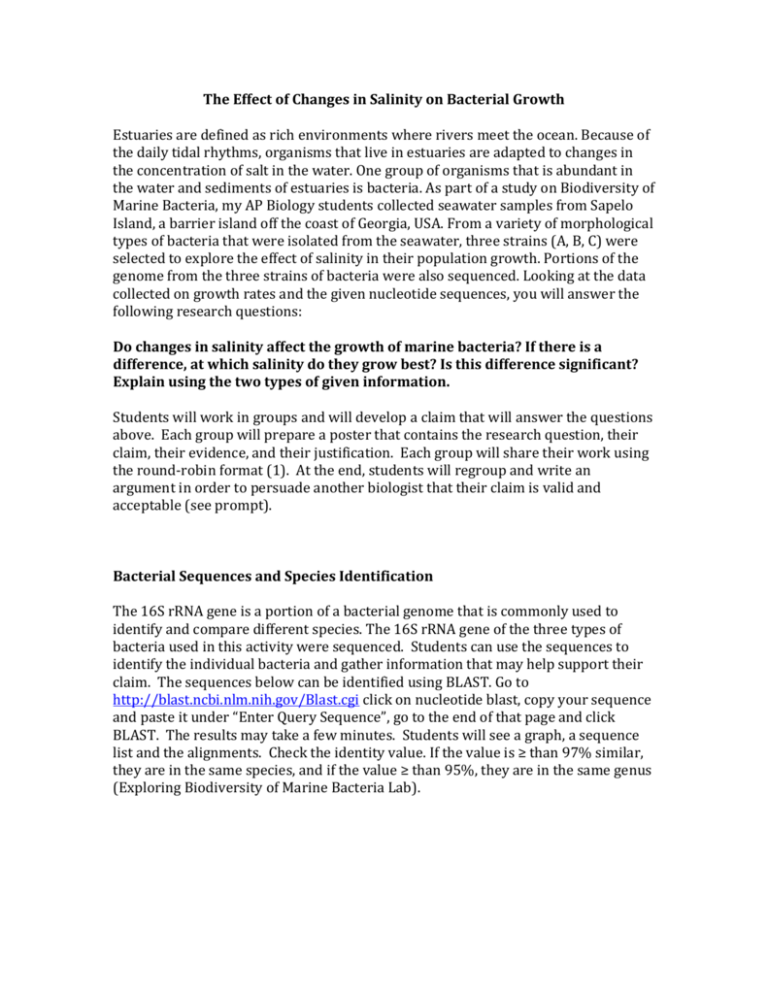
The Effect of Changes in Salinity on Bacterial Growth Estuaries are defined as rich environments where rivers meet the ocean. Because of the daily tidal rhythms, organisms that live in estuaries are adapted to changes in the concentration of salt in the water. One group of organisms that is abundant in the water and sediments of estuaries is bacteria. As part of a study on Biodiversity of Marine Bacteria, my AP Biology students collected seawater samples from Sapelo Island, a barrier island off the coast of Georgia, USA. From a variety of morphological types of bacteria that were isolated from the seawater, three strains (A, B, C) were selected to explore the effect of salinity in their population growth. Portions of the genome from the three strains of bacteria were also sequenced. Looking at the data collected on growth rates and the given nucleotide sequences, you will answer the following research questions: Do changes in salinity affect the growth of marine bacteria? If there is a difference, at which salinity do they grow best? Is this difference significant? Explain using the two types of given information. Students will work in groups and will develop a claim that will answer the questions above. Each group will prepare a poster that contains the research question, their claim, their evidence, and their justification. Each group will share their work using the round-robin format (1). At the end, students will regroup and write an argument in order to persuade another biologist that their claim is valid and acceptable (see prompt). Bacterial Sequences and Species Identification The 16S rRNA gene is a portion of a bacterial genome that is commonly used to identify and compare different species. The 16S rRNA gene of the three types of bacteria used in this activity were sequenced. Students can use the sequences to identify the individual bacteria and gather information that may help support their claim. The sequences below can be identified using BLAST. Go to http://blast.ncbi.nlm.nih.gov/Blast.cgi click on nucleotide blast, copy your sequence and paste it under “Enter Query Sequence”, go to the end of that page and click BLAST. The results may take a few minutes. Students will see a graph, a sequence list and the alignments. Check the identity value. If the value is ≥ than 97% similar, they are in the same species, and if the value ≥ than 95%, they are in the same genus (Exploring Biodiversity of Marine Bacteria Lab). Sequences Strain A TCAGCGCAGNTNANAGCTTGCACTTCGCTGACGAGTGGCGGACGGGTGAGTAATGCTTGGGAACTTGCCTT TGCGAGGGGGATAACAGTTGGAAACGACTGCTAATACCGCATAATGTCTTCGGACCAAACGGGGCTTAGGC TCCGGCGCAAAGAGAGGCCCAAGTGAGATTAGCTAGTTGGTGGGGTAAAGGCTCACCAAGGCGACGATCTC TAGCTGTTCTGAGAGGAAGATCAGCCACACTGGGACTGAGACACGGCCCAGACTCCTACGGGAGGCAGCAGT GGGGAATATTGCACAATGGGGGAAACCCTGATGCAGCCATGCCGCGTGTGTGAAGAAGGCCTTCGGGTTGT AAAGCACTTTCAGTTGTGAGGAAAGATTGGTAGTTAATACCTGCCAGTTGTGACGTTAGCAACAGAAGAAG CACCGGCTAACTCCGTGCCAGCAGCCGCGGTAATACGGAGGGTGCAAGCGTTAATCGGAATTACTGGGCGTA AAGCGCACGCAGGCGGTTTGTTAAGCTAGATGTGAAAGCCCCGGGCTCAACCTGGGATGGTCATTTAGAACT GGCAGACTAGAGTCTTGGAGAGGGGAGTGGAATTCCAGGTGTAGCGGTGAAATGCGTAGATATCTGGAGGA ACATCAGTGGCGAAGGCGACTCCCTGGCCAAAGACTGACGCTCATGTGCGAAAGTGTGGGTAGCGAACAGG ATTAGATACCCTGGTAGTCCACACCGTAAACGCTGTCTACTAGCTGTGCGTGAATTTAATTTGTGCGTAGCG AAGCTAACGCGATAAGTAGACCGCCTGGGGAGTACGGCCGCAAGGTTAAAACTCAAATGAATTGACGGGGG CCCGCACAAGCGGTGGAGCATGTGGTTTAATTCGAAGCAACGCGAAGAACCTTACCTACACTTGACATGCAG AGAATTTTCCA Strain BATGGGAGCTTGCTCCCTGATATCAGCGGCGGACGGGTGAGTAACACGTGGGTAACCTGCCTGTAAGACTGGG ATAACTCCGGGAAACCGGGGCTAATACCGGATAACTCATTTCCTCGCATGAGGAAATGTTGAAAGGTGGCT TTTANCTACCACTTACAAATGGACCCGCGGCGCATTACCTAGTTGGTGAGGTAACGGCTCACCAAGGCAACA ATGCGTAGCCAACCTGAAAGGGTGATCGGCCACCCTGGGACTGAAACACGGCCCAAACTCCTACGGGAGGCA GCATTAGGGAATCTTCCGCAAGGGACAAAAGTCTGACGGACCACCCCCCCGGGAGTGATGAAGGTTTTCGGA TCGTAAAGCTCTGTTGTTAGGGAAAAACAANTGCCGTTCGAATAGGGCGGCACCTTGACGGTACCTAACCA AAAAGCCACGGCTAACTACNTGCCACCANCCGCGGTAATACNTAGGTGGCAAGCNTTGTCCGGAATTATNG GGCGTAAAGCGCGCGCAGGTGGTTCCTTANNTCNGATGTGAAAGCCNACGGCTCACCCGTGAAGGGTCATT GNAAACTGGGNAACTTGANTGCNNANAAGGAAAGTGNAATTCCAAGTGTANCGGTGAANTGCGTAGATNT TTGNAGGANCACCANTGGCGAAGGNGACTTTCTGGTCTGTAACTGACACTGAGGCGCGAAAGCNTGGGGNA GCAAACAGGATTAGATACCCNNGNNAGTCNACGCCGTAAACGATGANNGCTAGTNGNTAGGGGGTTTCGG CCCCTTANNGCTGCAGCTAACGCA Strain C GAGCGGATGAGAGGAGCTTGCTCCTCGATTCAGCGGCGGACGGGTGAGTAATGCCTAGGAATCTGCCTAGTA GTGGGGGACAACGTTTCGAAAGGAACGCTAATACCGCATACGTCCTACGGGAGAAAGTGGGGGATCTTCGG ACCTCACGCTATTAGATGAGCCTAGGTCGGATTAGCTAGTTGGTAGGGTAAAGGCCTACCAAGGCGACGATC CGTAACTGGTCTGAGAGGATGATCAGTCACACTGGAACTGAGACACGGTCCAGACTCCTACGGGAGGCAGCA GTGGGGAATATTGGACAATGGGCGAAAGCCTGATCCAGCCATGCCGCGTGTGTGAAGAAGGCCTTCGGGTCG TAAAGCACTTTAAGTTGGGAGGAAGGGCTCATAGCGAATACCTGTGAGTTTTGACGTTACCAACAGAATAA GCACCGGCTAACTTCGTGCCAGCAGCCGCGGTAATACGAAGGGTGCAAGCGTTAATCGGAATTACTGGGCGT AAAGCGCGCGTAGGTGGCTTGATAAGTTGGATGTGAAATCCCCGGGCTCAACCTGGGAACTGCATCCAAAAC TGTCTGGCTAGAGTGCGGTAGAGGGTAGTGGAATTTCCAGTGTAGCGGTGAAATGCGTAGATATTGGAAGG AACACCAGTGGCGAAGGCGACTACCTGGACTGACACTGACACTGAGGTGCGAAAGCGTGGGGAGCAAACAG GATTAGATACCCTGGTAGTCCACGCCGTAAACGATGTCAACTAGCCGTTGGGATCCTTGAGATCTTAGTGGC GCAGCTAACGCATTAAGTTGACCGCCTGGGGAGTACGGCCGCAAGGTTAAAACTCAAATGAATTGACGGGG GCCCGCACAAGCGGTGGAGCATGTGGTTTAATTCGAAGCAACGCGAAGAACCTTACCTGGGCCTTGACATGC TGANNACTTTCCAGANATGGATTGGTGCCTTCGGGAACTCAGA Data on Salinity for Strain A The table below shows the data collected on bacterial growth for strain A over 25 hours. These tests were performed at three different concentrations of salinity in a liquid growth medium. Each value represents the density of the bacterial culture (measured as absorbance at a wavelength of 600 nm), and was multiplied by a 1,000 in order to simplify the data for graphing purposes. The salinity of ocean water is 3%, and the salinity of fresh water is 0%. The values shown below are averages, calculated from three replicates per salinity concentration. Time 0% 1% 2% 3% 1 2 3 4 5 6 7 8 9 10 11 12 13 14 15 16 17 18 19 20 21 22 23 24 25 1.1 1.2 0.4 0.5 0.7 0.8 0.9 0.8 0.9 1 1.5 1.6 1.8 2.4 2.6 2.7 2 3 2.3 3.2 3.3 3.5 3.6 3.7 3.8 -1.2 -1.1 0 2.3 4.7 8.3 12.8 18.5 30.8 34.1 44.3 89.9 195.4 297.1 414.1 472.3 521.6 568.5 611.2 647.7 680.7 706.8 718.4 711.9 673.3 1.4 2.1 4.8 10.7 20.1 46.7 73.4 114.4 159.4 270.8 356.9 385.3 473.6 556.6 652.6 679.1 698.2 712.1 723.3 665.7 636 622.6 605.1 599 586.9 2.3 2.9 4.2 9 24.6 27.9 31.7 19.3 33.7 70.5 180 272.2 338.5 390.9 448.4 504.4 565.6 589.8 585.4 574.4 579.2 581.9 571.1 567.8 562.6 Data on Salinity for Strain B The table below shows the data collected on bacterial growth for strain B over 25 hours. These tests were performed at three different concentrations of salinity in a liquid growth medium. Each value represents the density of the bacterial culture (measured as absorbance at a wavelength of 600 nm), and was multiplied by a 1,000 in order to simplify the data for graphing purposes. The salinity of ocean water is 3%, and the salinity of fresh water is 0%. The values shown below are averages, calculated from three replicates per salinity concentration. Time 0% 1% 2% 3% 1 0.7 0.8 0.4 -4.2 2 0.8 0.9 0.5 2.7 3 4 5 6 7 8 9 10 11 12 13 14 15 16 17 18 19 20 21 22 23 0.9 1 1.1 1.1 1.2 2.3 3.6 8 18.5 48.2 108.8 200.6 260.5 189.6 191 215.9 260.7 312.6 324.9 409.2 419.2 1.1 1.2 1.7 2.8 6.4 17.4 46.2 126.7 257.5 370.5 436 477.7 530.4 569.7 629.5 666.2 692.9 689.7 726 704.5 703.7 0.6 0.7 1.4 1.8 5.4 16 44.7 122.8 257.1 373.7 437.6 495.2 549.1 595.2 638.2 681.5 720.8 734.7 744.1 749.2 791.2 2.1 2.2 3.2 3.2 5.8 12.1 29.7 78.7 201.8 317.6 404.1 467.1 522.7 560.9 604.7 645.8 673.7 691.5 707.5 718 735.2 24 25 450.3 443.3 729.1 729.7 779.7 810.2 750.3 767.2 Data on Salinity for Strain C The table below shows the data collected on bacterial growth for strain C over 25 hours. These tests were performed at three different concentrations of salinity in a liquid growth medium. Each value represents the density of the bacterial culture (measured as absorbance at a wavelength of 600 nm), and was multiplied by a 1,000 in order to simplify the data for graphing purposes. The salinity of ocean water is 3%, and the salinity of fresh water is 0%. The values shown below are averages, calculated from three replicates per salinity concentration. Time 0% 1% 2% 3% 1 0 0.4 0.7 3 2 0.4 0.5 1 1.9 3 4 5 6 7 8 9 10 11 12 13 14 15 16 17 18 19 20 21 22 23 1.4 0.4 1.4 0.8 2.3 2.6 6.7 16.1 34.6 72.4 129.7 202.4 230.3 274.9 318.8 350.1 379.5 394.2 401.7 414.3 403.4 0.6 0.8 0.9 1.3 1.7 3.7 7.6 17.7 41.4 95.1 184 264.4 312.7 350 382.1 401 415.4 420.9 416.7 416.9 421.9 0.8 0.8 0.8 1.5 1.5 2.1 3.1 6 12.7 27.3 59.9 124.1 209.1 274.4 314.2 355.9 432 444.7 469.6 447.7 492.1 1.5 1.8 2.4 1.4 1.7 1.9 2.2 3 4.6 7.9 15.6 30.2 57.8 106 174.6 235.5 281.9 319.7 416.2 466.1 509.2 24 25 351.6 287.8 430.4 435 442 454.6 510.3 515.6 Rubric (adapted from Scientific argumentation in Biology 30 Classroom Activities by Victor Sampson and Sharon Schleigh, NSTA press 2013) Aspect of Argument The Claim The claim is sufficient The claim is accurate The Evidence Includes data Includes analysis of data Includes an interpretation of the analysis The Justification of the Evidence Explains why the evidence is important or why it is relevant Links the evidence to an important concept or principle Language of Science Appropriate use of scientific terms Mechanics Good organization Argument written in complete sentences/good spelling and punctuation Points (max 10 points) Comments
